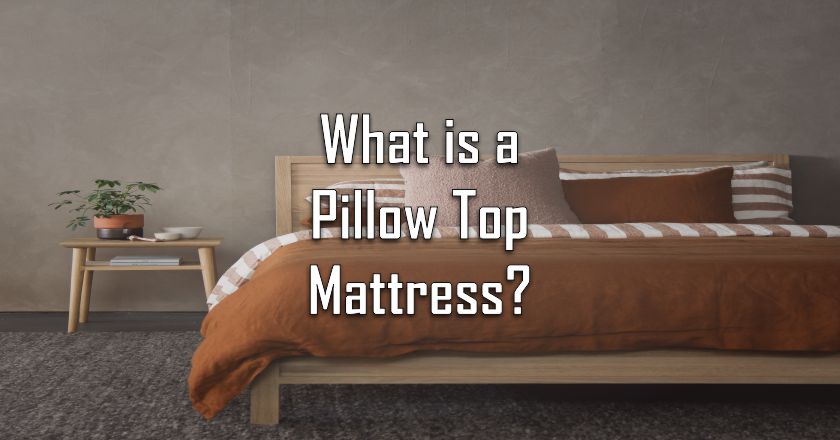The top of a pillow-top mattress is padded with additional soft fabric. When lying on a pillowtop mattress, you will feel like you are resting on a cloud. These beds are best for side sleepers who weigh less than 130 pounds.
This article delves into the purpose of a pillow top mattress, its benefits, pros and cons, manufacturing process, and more.
What is the Purpose of a Pillow Top Mattresses?
A pillow top mattress is designed to offer a plush and cushioned surface for sleep. It features an additional layer of padding sewn onto the top of the bed.
Pillow toppers are helpful for all sleepers, notably side, and combination, because of their extra support at pressure areas. The mattress will shape your shoulders and hips, helping maintain proper spinal alignment and joint ease.
Benefits and Drawbacks of Pillow Top Mattresses
Pillow Top mattresses aim to provide a balance between plush comfort and essential support, catering to a variety of sleep preferences.
While pillow top mattresses offer several benefits, it’s essential to consider their advantages and potential drawbacks before purchasing.
Benefits:
- Enhanced Comfort: A pillow top mattress’s main benefit is its enhanced comfort. The extra padding provides a luxurious and cozy surface that can make falling asleep more inviting.
- Pressure Point Relief: Pillow top mattresses excel at distributing body weight evenly, reducing pressure on sensitive areas like shoulders, hips, and knees.
- Motion Isolation: The cushioning in a pillow top mattress minimizes motion transfer, making it an excellent option for couples.
- Temperature Regulation: Some pillow top mattresses incorporate cooling gel or breathable materials, helping regulate body temperature and prevent overheating during sleep.
- Supportive for Side Sleepers: Side sleepers often benefit from the contouring properties of pillow top mattresses. The padding supports the curves of the body, promoting proper spinal alignment.
- Luxurious Feel: If you enjoy a plush and opulent sleeping surface, a pillow top mattress provides that hotel-like experience in your bedroom.
Drawbacks:
- Durability: One of the main drawbacks of pillow top mattresses is their reduced durability. The extra padding can compress and lose shape over time, leading to uneven support and lessened comfort.
- Maintenance: Pillow Top mattresses may require more maintenance to keep them in good condition.
- Heat Retention: Some pillow top mattresses can trap heat due to the additional layer of padding. If you’re a hot sleeper, this could lead to discomfort during the night.
- Weight: The added padding and materials can make pillow top mattresses heavier and more challenging to move, which might be a concern if you plan on relocating frequently.
- Less Support: While pillow top mattresses offer plush comfort, they might not provide the same support as firmer mattresses.
How are Pillow Top Mattresses Manufactured?
Pillow top mattresses undergo a specific manufacturing process to achieve their unique design. The process typically involves the following steps:
Base Mattress Creation
The mattress’s core uses traditional materials like innerspring coils, memory foam, or latex. This forms the base upon which the pillow top layer will be added.
Pillow Top Layer Addition
The pillow top layer, made from materials like memory foam or fiberfill, is sewn onto the top surface of the base mattress. This layer is often quilted to hold the padding in place.
Quilting and Stitching
The pillow top layer is quilted and stitched to the mattress to create individual padding pockets. This stitching helps prevent the padding from shifting or becoming uneven over time.
Finishing Touches
The mattress is finished with a cover made from fabric that complements the overall design. Some covers are designed to be breathable and cooling.
Conclusion
Investing in a pillow top mattress can significantly impact the quality of your sleep. These mattresses offer enhanced comfort, pressure relief, and motion isolation by providing an extra layer of soft padding.
While they may come with a higher price tag and potential durability concerns, their benefits can make them a valuable addition to your bedroom.
If you prioritize a plush and luxurious sleeping surface, a Pillow Top mattress might be the key to unlocking a more restful night’s sleep.
FAQs
Can Side Sleepers Use a Pillow Top Mattress?
A pillow top mattress is fantastic for all sleeping positions, especially side sleeping. They provide consistent comfort in any sleeping position, helping to alleviate pain.
Is It Better for Your Back to Sleep on a Pillow Top Mattress?
People with back or joint discomfort benefit significantly from this style of bed.
What is a Good Alternative for a Pillow Top Mattress?
Sleepers who want the bounce and support of springs can choose from hybrid versions of the AS2, AS3, and AS5 mattresses. If you’re looking for a bed with the benefits of a pillow top without the cons, a hybrid mattress may be the way to go.
Are Pillow Top Mattresses Prone to Sagging?
Pillow-top mattresses sag more than other types of mattresses. The soft materials on the bed’s surface compress and degrade with time.
You can avoid this by rotating your mattress regularly and moving the side of the mattress you sleep periodically if you sleep alone.
Are Pillow Top Mattresses Less Durable?
Compared to other mattresses, pillow top mattresses often have a shorter lifespan.

